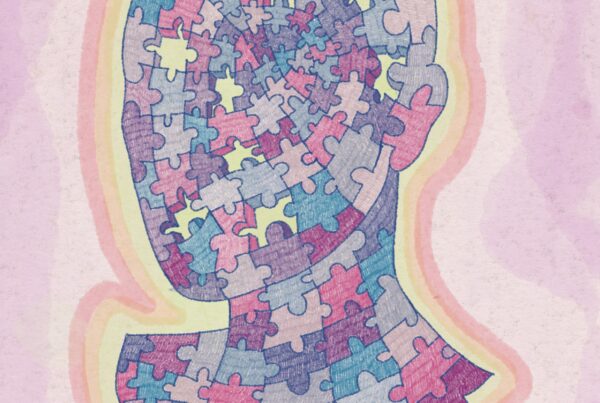
Imagine Mary, a brilliant scientist who studies colours. Although she has complete physical knowledge about colours, she has never seen them, because she is living in a black-and-white room. When she leaves the room and experiences colours for the first time, does she learn anything new?
Imagine Mary, a brilliant scientist who studies colours. Although she has complete physical knowledge about colours, she has never seen them, because she is living in a black-and-white room. When she leaves the room and experiences colours for the first time, does she learn anything new?

Photo by Museums Victoria on Unsplash

The point of this classic thought experiment (Jackson, 1982) is that even if you have complete physical information about colours – knowledge about how different wavelengths stimulate the retina, for example – you might still not know what it is like to see colours. Intuitively, the thought experiment tries to show how conscious experience involves non-physical properties.
Another intuitive example that Jackson introduced (1982) is the case of Fred. As it happens, Fred is the only person who can perceive a certain colour, while nobody else is able to see it. If you show Fred a spectrum of colours that includes all the colours you know, Fred will say that the colour he can perceive is not there. How could Fred ever explain what this specific colour looks like? How could neuroscientists ever find out what it is like to see that colour, even if they have analysed Fred’s brain completely? The experience of colours, as it seems, has something non-physical about it.
Of course, you will have guessed by now that colours only serve as an example for conscious experience as a whole. Whoever you are, dear reader, I am sure that there is a certain conscious experience of being you that only you have. Will anyone else ever know what it feels like to be you? Similarly, no matter how much we study the brains of animals – will we ever know what it’s like to be a certain animal? Intuitively, the answer is no; and many philosophers have used thought experiments like these to attack the philosophical position of physicalism (for another prominent example, see Nagel, 1974).
To understand physicalism, consider the case of zombies. No, I’m not talking about undead corpses wildly running after you and trying to eat you. A philosophical zombie is a human like any other – in fact, they are physically completely identical. The key difference is that the zombie does not have any conscious experience. If you hit a zombie, it will say ouch, its neurons will fire, it might get a swelling on the spot at which you hit it. But it won’t actually feel any pain – although it behaves exactly like if it does. Do you think that such a being can, in principle, exist? If your answer is no, then you are probably a physicalist.
“Whether we have a conscious experience makes a difference to us.”
Of course, that is not exactly the definition of physicalism that philosophers use – for this, we have to introduce another fancy term: supervenience. Imagine a painting – let’s say the Mona Lisa. Now imagine that there is another painting which is physically completely identical: It consists of the same molecules as the original Mona Lisa. In this case, the replica will also show the same image. It’s not possible that a painting has the same physical microstructure as the Mona Lisa, all while depicting something else. In other words, the image a painting shows supervenes on the painting’s physical properties. Physicalism claims that everything supervenes on the physical, including the mind. Hence, the physicalist argues that it is impossible for a being to be physically identical to a normal human without having the same mental properties (which makes philosophical zombies impossible).
But how can these concepts help us understand the case of Mary, the colour scientist? If we examine the scenario more closely, we realize that it’s intuitive because conscious experience changes the way we behave and live. If Mary perceives colour for the first time when seeing a field of blooming flowers, she will be overwhelmed by the colourful experience. Her visual system will be exposed to something it has never seen before, and she might exclaim how wonderful colours are. In short, whether we have a conscious experience makes a difference to us.
Yet, what happens when we think about Zombie-Mary? By definition, Zombie-Mary doesn’t have any conscious experience; so what would happen if she is released from the black-and-white room? As she is a zombie who doesn’t have a conscious experience of colour, it seems that she would therefore not gain any new knowledge after being released from her black-and-white room. Nevertheless, she would behave exactly the same as real Mary: Zombie-Mary would be equally ‘overwhelmed’ by the field of blooming flowers she sees, and her visual system would react in the same way. But in the case of Zombie-Mary, it’s not clear what has actually caused this behaviour, since Zombie-Mary does not have any conscious experience of colours. The thought experiment with real Mary is intuitive because it suggests that the conscious experience of colours does make a difference to her behaviour, while the scenario with Zombie-Mary shows that conscious experience is in fact not necessary to cause behaviour. Instead, the thought experiment with Zombie-Mary indicates that Zombie-Mary was apparently missing some kind of information other than conscious experience – otherwise, there couldn’t have been anything that caused Zombie-Mary’s change in behaviour after being released (Vierkant, 2002).
“There is no final answer to the problem of consciousness.”
But let’s leave the complicated reasoning behind and go back to our original question of how it is possible to know what the conscious experience of colours is like without having seen them. Imagine that one day, Fred is in fact able to see a colour that no one else perceives. In order to uncover what seeing this mysterious colour is like, a group of neuroscientists examine Fred’s brain. Using state-of-the-art (not yet existing) neuroimaging methods, the neuroscientists are able to exactly identify which individual neurons are firing when Fred sees the mysterious colour. They then develop an advanced brain stimulation machine that is able to perfectly control the brain that is hooked up to the machine. Through this machine, the brain of a person who has not seen the mysterious colour could be stimulated and transformed towards the same state Fred’s brain is in when he sees the colour. As a consequence, other people would have knowledge about what it’s like to see the colour, without ever actually having seen it. Do you think something like this is theoretically possible?
As you can see, there is no final answer to the problem of consciousness, but I hope that all the arguments described here show that there is nevertheless progress concerning this question. It’s easy to dismiss philosophy based on the observation that philosophers apparently are not able to come up with ‘final’ answers, although this is not always true. And concerning cases in which it is true, we shouldn’t forget that they are often among the hardest problems humankind is facing today. <<
References
– Jackson, F. (1982). Epiphenomenal Qualia. Philosophical Quarterly, 32. 127-.136.
– Nagel, T. (1974). What is it like to be a bat?. The philosophical review, 83(4), 435-450.
– Vierkant, T. (2002). Zombie-Mary and the Blue Banana. Psyche, 8, 19.
The point of this classic thought experiment (Jackson, 1982) is that even if you have complete physical information about colours – knowledge about how different wavelengths stimulate the retina, for example – you might still not know what it is like to see colours. Intuitively, the thought experiment tries to show how conscious experience involves non-physical properties.
Another intuitive example that Jackson introduced (1982) is the case of Fred. As it happens, Fred is the only person who can perceive a certain colour, while nobody else is able to see it. If you show Fred a spectrum of colours that includes all the colours you know, Fred will say that the colour he can perceive is not there. How could Fred ever explain what this specific colour looks like? How could neuroscientists ever find out what it is like to see that colour, even if they have analysed Fred’s brain completely? The experience of colours, as it seems, has something non-physical about it.
Of course, you will have guessed by now that colours only serve as an example for conscious experience as a whole. Whoever you are, dear reader, I am sure that there is a certain conscious experience of being you that only you have. Will anyone else ever know what it feels like to be you? Similarly, no matter how much we study the brains of animals – will we ever know what it’s like to be a certain animal? Intuitively, the answer is no; and many philosophers have used thought experiments like these to attack the philosophical position of physicalism (for another prominent example, see Nagel, 1974).
To understand physicalism, consider the case of zombies. No, I’m not talking about undead corpses wildly running after you and trying to eat you. A philosophical zombie is a human like any other – in fact, they are physically completely identical. The key difference is that the zombie does not have any conscious experience. If you hit a zombie, it will say ouch, its neurons will fire, it might get a swelling on the spot at which you hit it. But it won’t actually feel any pain – although it behaves exactly like if it does. Do you think that such a being can, in principle, exist? If your answer is no, then you are probably a physicalist.
“Whether we have a conscious experience makes a difference to us.”
Of course, that is not exactly the definition of physicalism that philosophers use – for this, we have to introduce another fancy term: supervenience. Imagine a painting – let’s say the Mona Lisa. Now imagine that there is another painting which is physically completely identical: It consists of the same molecules as the original Mona Lisa. In this case, the replica will also show the same image. It’s not possible that a painting has the same physical microstructure as the Mona Lisa, all while depicting something else. In other words, the image a painting shows supervenes on the painting’s physical properties. Physicalism claims that everything supervenes on the physical, including the mind. Hence, the physicalist argues that it is impossible for a being to be physically identical to a normal human without having the same mental properties (which makes philosophical zombies impossible).
But how can these concepts help us understand the case of Mary, the colour scientist? If we examine the scenario more closely, we realize that it’s intuitive because conscious experience changes the way we behave and live. If Mary perceives colour for the first time when seeing a field of blooming flowers, she will be overwhelmed by the colourful experience. Her visual system will be exposed to something it has never seen before, and she might exclaim how wonderful colours are. In short, whether we have a conscious experience makes a difference to us.
Yet, what happens when we think about Zombie-Mary? By definition, Zombie-Mary doesn’t have any conscious experience; so what would happen if she is released from the black-and-white room? As she is a zombie who doesn’t have a conscious experience of colour, it seems that she would therefore not gain any new knowledge after being released from her black-and-white room. Nevertheless, she would behave exactly the same as real Mary: Zombie-Mary would be equally ‘overwhelmed’ by the field of blooming flowers she sees, and her visual system would react in the same way. But in the case of Zombie-Mary, it’s not clear what has actually caused this behaviour, since Zombie-Mary does not have any conscious experience of colours. The thought experiment with real Mary is intuitive because it suggests that the conscious experience of colours does make a difference to her behaviour, while the scenario with Zombie-Mary shows that conscious experience is in fact not necessary to cause behaviour. Instead, the thought experiment with Zombie-Mary indicates that Zombie-Mary was apparently missing some kind of information other than conscious experience – otherwise, there couldn’t have been anything that caused Zombie-Mary’s change in behaviour after being released (Vierkant, 2002).
“There is no final answer to the problem of consciousness.”
But let’s leave the complicated reasoning behind and go back to our original question of how it is possible to know what the conscious experience of colours is like without having seen them. Imagine that one day, Fred is in fact able to see a colour that no one else perceives. In order to uncover what seeing this mysterious colour is like, a group of neuroscientists examine Fred’s brain. Using state-of-the-art (not yet existing) neuroimaging methods, the neuroscientists are able to exactly identify which individual neurons are firing when Fred sees the mysterious colour. They then develop an advanced brain stimulation machine that is able to perfectly control the brain that is hooked up to the machine. Through this machine, the brain of a person who has not seen the mysterious colour could be stimulated and transformed towards the same state Fred’s brain is in when he sees the colour. As a consequence, other people would have knowledge about what it’s like to see the colour, without ever actually having seen it. Do you think something like this is theoretically possible?
As you can see, there is no final answer to the problem of consciousness, but I hope that all the arguments described here show that there is nevertheless progress concerning this question. It’s easy to dismiss philosophy based on the observation that philosophers apparently are not able to come up with ‘final’ answers, although this is not always true. And concerning cases in which it is true, we shouldn’t forget that they are often among the hardest problems humankind is facing today. <<


